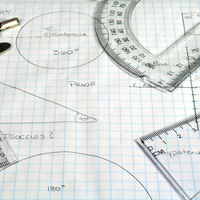As a high schooler, you are required to take at least a few years of math. For a subject that is so prominent in the high school curriculum, there’s still a lot of misconceptions. Many people think that you are either good at math or bad at math; there’s no in-between and there’s no way to succeed if you’ve always struggled — that’s about as false as 2+2=5.
While some people have certain skill sets that lend nicely to math classes, there are math study strategies that can be learned and mastered by all students to succeed. How do you exercise these strong study strategies for math, you ask? It’s as easy as 1, 2, 3…
1. Think of math as a process — know the steps
Getting the correct answer is always a great feeling, but if you don’t know how you got to that answer, you may be in trouble. Math is incredibly process based; step by step you are required to know the procedures. Think of math like cooking: if you forget an ingredient, the end result is ruined, and you need to pay careful attention to each task. So, how do you focus more on math as a process?
-
Show your work, from beginning to end. Whether you’re studying for a test, doing homework, or completing a quiz, you should be writing down all of your steps. This will help you in the long run if you notice you are getting problems incorrect. When you show your work, you can isolate the errors and identify exactly where you need to go back to study. When you are told to show your work on a test, show all of your work. Even if your final answer isn’t correct, you could still get partial credit for the process you used.
-
Learn your formulas — what they are and how to use them. Math isn’t like a history class; you can’t just memorize the terms and ace the exam. Memorizing a math formula is only the beginning. If you don’t know what each piece of the formula means, when to use it, and how it will help, you won’t be as successful with it. You should utilize your textbook, math notes, and potentially math practice tests to get an in-depth understanding of key math formulas for your class.

2. Go back to the basics
Math concepts build upon one another, which is one of the reasons it can get harder and harder as the years go on. If you struggle with basic math concepts, you may continue to struggle as you get into more difficult processes. Not only will your material become more challenging as the year progresses, you may be required to know and apply information from previous math classes. Here are some study strategies that can help you learn the basics and avoid falling behind:
-
When possible, draw things out (just like you learned in elementary school). It’s effective! Would a diagram help? How about a chart? Even if a graph isn’t necessary, visualizing the problem can help you determine what exactly you are dealing with. This can be particularly helpful for those who consider themselves visual learners.
-
Keep your math notes from previous classes, and refer back to them when necessary. Just because you are in a geometry class doesn’t mean your algebra notes might not come in handy later. Hold on to your old class materials and reference them if you’re struggling with old concepts. Be sure to understand the foundation of these concepts before you try to master harder ones. Consider also consulting your teacher or seeking math tutoring to help shed light on some of the areas that confuse you.
[RELATED: Is Your Child Ready for Algebra?]
3. Tackle each problem methodically
When you look at a four-page test, don’t think of the test as a whole. Instead, think of each problem as its own test, with its own challenges and its own strategy. There are methodical approaches you can use to solve each problem successfully…
-
Determine what the question is asking. This may seem like an obvious first step, but especially with word problems, the actual question can sometimes get buried. Some students see the numbers and automatically start solving a problem before they even know what that problem is exactly. You don’t want to waste your time and energy solving a question that isn’t being asked! Once you have a confident understanding of the question at hand, you can start to tackle it for the solution. Also note that sometimes you’ll need to consider whether it is a two-part question. For instance, do you have to solve one problem first in order to get the information to solve another problem?
-
Highlight or underline important words, phrases, and numbers. Sometimes, word problems include bits of information that you don’t necessarily need. The extra information in these problems is often intended to confuse you and see if you can determine the relevant materials. Isolating the information you need to use can help you clearly identify the process you should use to find the answer.
Any topics you want to know more about? Let us know! The Varsity Tutors Blog editors love hearing your feedback and opinions. Feel free to email us at blog@varsitytutors.com.

